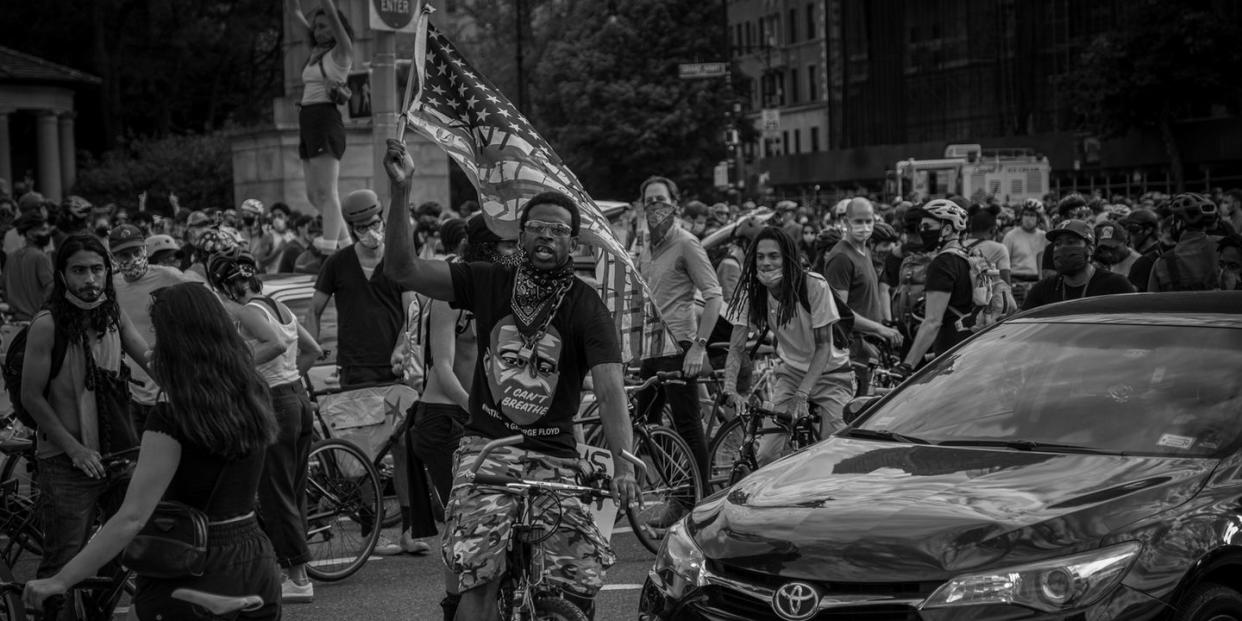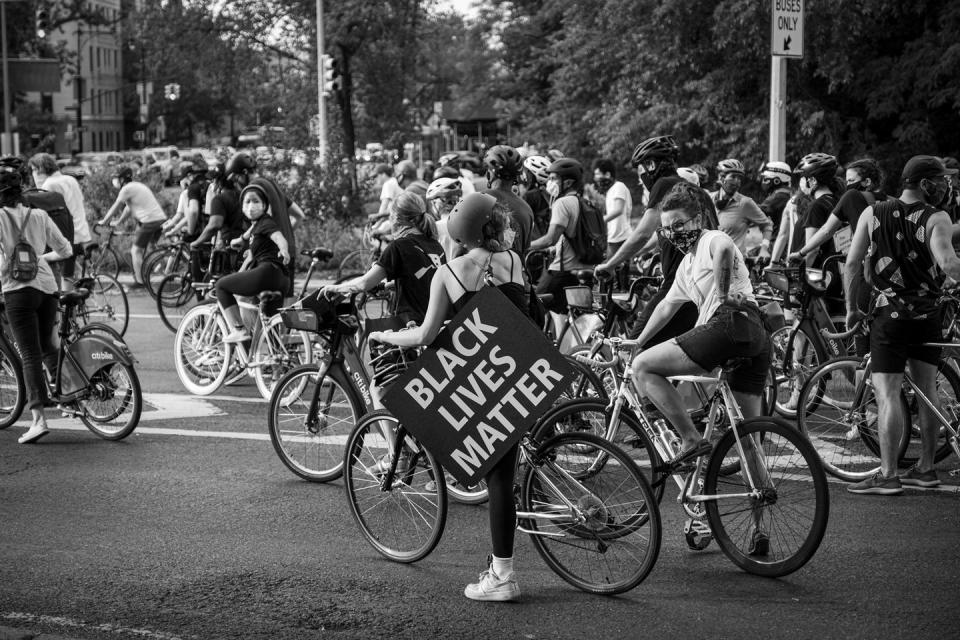How Protestors Are Using Their Bikes to Fight Racism

In the weeks since Black Lives Matter protesters took to the streets in cities across the country, bikes have become more than simply a method of transportation. They’ve become a tool for societal change. In New York City, activists have organized bike-specific marches: mass rides, galvanizing thousands of cyclists, from seasoned riders to occasional Citi Bikers to newbie pandemic-pedallers. (In solidarity, Citi Bike announced it’s waiving rider fees.) The rides typically depart from Grand Army Plaza in Brooklyn’s Prospect Park and roll for a few hours, traversing bridges and boroughs, cyclists chanting through the streets, cardboard signs propped up in bike baskets and taped to the frames.

On Friday evening, a group known as Street Riders NYC organized the bike march, emphasizing in an Instagram post that the ride was “Black-led,” and “in support of our Black communities and the fight against injustice, racism and police brutality.” The seven-man cycling team met during the first couple Black Lives Matter bike protests that Saturday and Monday, and quickly saw the need for coordinated, justice-driven leadership.
“I wanted to make sure that people knew that this was ‘by us, for us,’” said Street Riders co-founder Orlando Hamilton, a 28-year-old chef who lives in Brooklyn.
For Hamilton, the mission is also personal. “In high school one of my close friends got killed by the police without any closure,” he said. “My older brother also has mental issues, on and off, and the police always treated him like shit instead of treating him like he needs some help.”
Hamilton believes protesting via bike has an unrivaled momentum. “You can’t really stop 5,000 bikes going down the street. You can try it, but bikes are kind of fast, we can just ride right around you,” he said. “Also, it sets up a sort of perimeter, a wall that police can’t really infiltrate.”
In the first week of protests, the NYPD illegally swiped bikes from protesters, and in response to cops using their bikes to beat and intimidate protesters, some cycling brands such as Fuji Bikes have stopped selling bikes to police departments. But the recent solidarity rides have seen little resistance.
Ted Gusek, a photographer who volunteers with Time’s Up, a New York city grassroots environmental group that organizes monthly Critical Mass rides to advocate for cyclist rights, agrees the bike swarms make it “easier to evade the police.” Gusek organized Saturday’s and Monday’s rides; now, he says he’s taking a backseat so the Street Riders can lead, but helps promote the rides, and is pleasantly surprised by how quickly word spreads.
“I thought maybe we’d get a couple hundred people and link up with others protesting to be barriers between them and the police, but then it just got much larger than anticipated and we’ve just been going with it,” said Gusek. “I heard on Monday, anywhere from 2,000 to 6,000 people came out. By the end of that night we took five bridges. It all happens organically. It’s just a beautiful, beautiful thing.”
The sheer volume of these mass rides appeals to some New York cyclists, for whom the swift-moving unit is a protective force, allowing a freedom in the streets they’re not used to.
“Doing this kind of thing with a big crowd of bikers makes it feel pretty safe. Love not worrying about cars, the energy is great,” said Selena Josephs, a 35-year-old who works for a labor union and lives in Crown Heights. Ten years ago, Josephs had quit riding after someone she knew was killed on their bike, and she herself had a near accident. She says that since the pandemic, she started cycling again. “I feel more comfortable than I thought I would. I like this way of protesting and making our voices heard. Plus, it was important to me that it was a black-led event, too.”

Genesis Hart, a 24-year-old active protester who cycles and skateboards for fun and to get to her job at a pizzeria in Williamsburg, said that the bike rallies “give people a different alternative [to marching], and allow us to express in a different way.”
“Also, not everybody can walk for miles, but it’s easier for them to hop on a bike and just cruise,” she added. “It speaks to what people know and what they’re comfortable with, and it allows for more inclusion.”
The increased range provided by bikes also offers the opportunity to affect more people. “By cycling, we’re able to reach more people because we have wheels, because our voices are being heard. We’re moving as a pack, as a community, not like a gang—we’re just trying to send a positive message and understanding that this is something that needs some type of change, now,” said Taurean Coppin, founder of MindBody Results Cycling, a biking fitness group that also leads Black Lives Matter rides. “It doesn’t matter if we do it today, tomorrow, next week, we’re going to keep trying to push the same message over and over.”
On Friday, the Street Riders led the group through East New York and Brownsville, underserved areas that notoriously lack bike lanes and well-paved streets.
Jameson Croasdale, a safer streets advocate and founder of Instagram account On The Bike Lane, said that he really appreciated that the Street Riders “didn’t just ride through Fort Greene, down to Williamsburg,” but drew attention to lower-income neighborhoods that desperately need better biking infrastructure. Croasdale said that while the immediate focus of the Black Lives Matter rides needs to be on “ending police-sanctioned murder of black people,” he hopes that if the mass rides continue, they could also “raise awareness about how transportation infrastructure is part of systemic racism and it needs to be changed so people can enjoy parks, get to work safely, all of that.”
Hamilton said the Street Riders want to keep the rides going, but have to be careful about pacing; last Saturday, they opted to cancel a ride, acknowledging that the back-to-back rides they held on Friday night and Saturday morning were “just too much.”
With thousands of cyclists showing up, Gusek also wants this momentum to continue into the long-term. “We don’t want to be a flash in the pan; we want to keep this going, we want to help bring about change, keep nudging at people,” he said.
The Street Riders are just getting started. The next ride is planned for the afternoon of Saturday, July 20, this time departing from Times Square. They launched a website, where they assert their commitment to protesting against racist police brutality, and offer support to protesters, providing an option to request a bike crew for your march and a way for volunteers-on-bike to connect.
You Might Also Like

